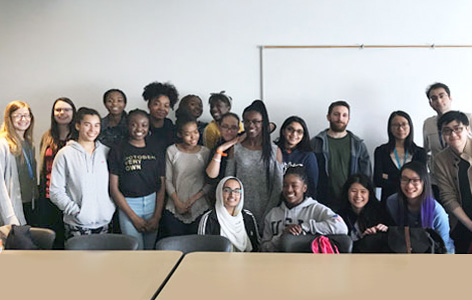
Community outreach may not be the number one priority on a graduate student’s to-do list. Between their responsibilities in the lab, class work, and second jobs in some cases, graduate students often have a lot on their plates. Importantly, students need to take time for themselves, whether it’s going to the gym or hanging out with friends. So, who really has time for extra-curricular activities?
For Leslie Oldfield, a Master’s student in the Department of Medical Biophysics, volunteering and hanging out with friends don’t have to be mutually exclusive. “We can all hang out with each other, but we can all hang out and do something good for the community at the same time,” she says.
Leslie is the founder of the Community Outreach Committee, which comprises a small but dedicated group of graduate students from her department. The group organizes science outreach and volunteering opportunities to enable graduate students to give back to their local community. Last year, they piloted March Break Camp, a week-long science outreach initiative that brought local high school students into UHN labs. Participants heard from professors, clinicians and graduate students about research, what it’s like to work at UHN, and why scientists do what they do.
This year, the group did things a little differently. In partnership with the Faculty of Medicine, they reached out to African-American and Indigenous students, and those coming from low-income neighbourhoods, providing them a glimpse of science, technology, engineering, and math (STEM) research. Because around 70% of the grade 11 participating students had never been exposed to STEM topics, the five-day camp provided some of them with their first exposure to cutting-edge scientific research.
Of the activities scheduled over the week, the students’ favourite was the hands-on wet lab component. Nothing beats getting your hands dirty in the lab and applying the science you’ve learned in the classroom. Under the guidance of a graduate student they studied HELA cells, a cervical cancer cell line. Other highlights of the week included touring some of the most sophisticated research facilities in Canada: the Advanced Optical Microscopy Facility and the Spatiotemporal Targeting and Amplification of Radiation Response facility.
March Break Camp is as much fun for the graduate trainees as it is for the high school students. Trainees get the chance to talk about their research, teach difficult concepts and inspire others to build a career science – all while hanging out with their friends and giving back to the community.
Want to get involved with groups like the Community Outreach Committee? Contact your department to find out what they have to offer, or check out the University of Toronto branch of Let’s Talk Science for science outreach opportunities. And of course, you can always start your own group!




